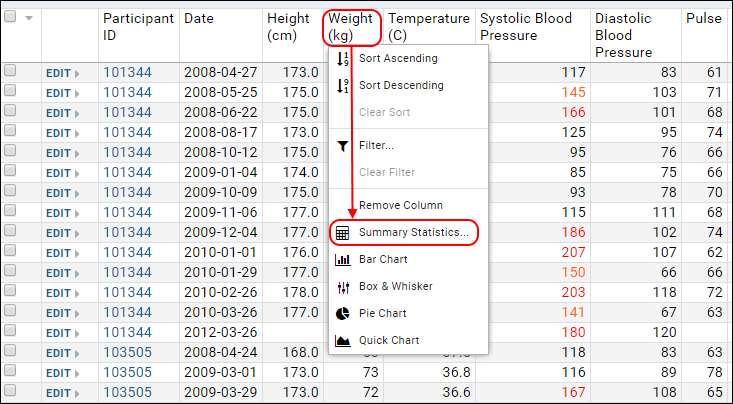[
Video Overview: Adding Summary Statistics to Data Grids ]
Add Summary Statistics to a Column
The list of statistics available in the popup vary based on the edition of LabKey Server you are running, and on the column datatype. Not all functions are available for all column types, only meaningful aggregates are offered. For instance, boolean columns show only the count fields, date columns do not include sums or means. Calculations ignore blank values, but note that values of 0 or "unknown" are not blank values.
All calculations use the current grid view and any filters you have applied. The number of digits displayed is governed by the
number format set for the container, which defaults to rounding to the thousandths place.
Summary statistics available in the Community edition include:
- Count (non-blank): The number of values in the column that are not blank, i.e. the total number of rows for which there is data available.
- Sum: The sum of the values in the column.
- Mean: The mean, or average, value of the column.
- Minimum: The lowest value.
- Maximum: The highest value.
Additional summary statistics available in Premium editions of LabKey Server include:
- Count (blank): The number of blank values.
- Count (distinct): The number of distinct values.
- Median: Orders the values in the column, then finds the midpoint. When there are an even number of values, the two values at the midpoint are averaged to obtain a single value.
- Median Absolute Deviation (MAD): The median of the set of absolute deviations of each value from the median.
- Standard Deviation (of mean): For each value, take the difference between the value and the mean, then square it. Average the squared deviations to find the variance. The standard deviation is the square root of the variance.
- Standard Error (of mean): The standard deviation divided by the square of the number of values.
- Quartiles:
- Lower (Q1) is the midpoint between the minimum value and the median value.
- Upper (Q3) is the midpoint between the median value and the maximum value. Both Q1 and Q3 are shown.
- Interquartile Range: The number of values between Q3 and Q1 in the ordered list. Q3-Q1.
Display Multiple Summary Statistics
Multiple summary statistics can be shown at one time for a column and each column may have it's own set. Here is a compound set of statistics on another dataset:

Related Topics
 Premium Feature — An enhanced set of summary statistics is available in the Professional, Professional Plus, and Enterprise Editions. Learn more or contact LabKey
Premium Feature — An enhanced set of summary statistics is available in the Professional, Professional Plus, and Enterprise Editions. Learn more or contact LabKey
